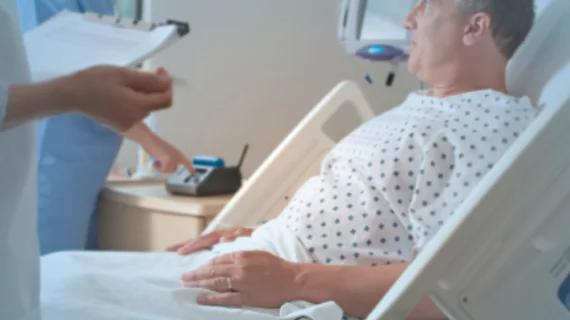Increasing survival rates for in-hospital cardiac arrest
Sometimes the planets align. This time, it’s to the advantage of patients at risk of in-hospital cardiac arrest. While a study recently confirmed cardiac arrest survival rates fall significantly on nights and weekends, another study shows that a wearable defibrillator can help patients 24/7.
Vulnerable times
When it comes to surviving in-hospital cardiac arrest (IHCA), it often depends when the event happens. Patients are at higher risk of dying on nights and weekends, according to a study published in the Journal of the American College of Cardiology (2018;71[4]:402-11). And the numbers are significant. More than half (52 percent) of the 209,000 in-hospital cardiac arrests (IHCAs) in the U.S. annually take place during ‘off-hours,’ according to lead author Uchenna R. Ofoma, MD, MS, of Geisinger Health System. The reasons most often cited for poorer outcomes are fewer physicians and experienced staff members being available or familiar with patients.
There is good news though in marked improvements in IHCA survival over the course of the study. From 2000 to 2014, risk-adjusted survival to discharge improved for both on-hours (16 percent to 25.2 percent) and off-hours (11.9 percent to 21.9 percent) IHCA. However, the survival rate remained significantly lower for off-hours vs. on-hours—a 3.3 percent absolute difference during the final year of the study. The absolute survival difference peaked at 5.3 percent in 2009.
Ofoma and colleagues found that patients who arrested during nights and weekends (11 p.m. to 6:59 a.m. Monday through Friday, and on weekends) were less likely to survive than those who suffered IHCA during on-hours. “Given the large burden of IHCA during off hours, there is an urgent need to focus quality improvement during this vulnerable period,” they concluded.
Around-the-clock protection
As work continues to remedy the problem, a new in-hospital wearable cardioverter defibrillator is helping to manage and protect patients at risk of sudden cardiac arrest.
This wearable defibrillator, which earned a PMA last year, is called the HWD (Hospital Wearable Defibrillator) from ZOLL Medical. This new device is specifically designed for the in-hospital environment, according to David M. Shavelle, MD, an associate clinical professor at Keck School of Medicine Division of Cardiology at the University of Southern California (USC), director of Los Angeles County (LAC) USC Cardiac Catheterization Laboratory, director of the general cardiology fellowship program at USC, and one of the investigators who performed a clinical evaluation of HWD use in hospitals.
Via continuous monitoring, wearable defibrillators can rapidly identify malignant ventricular arrhythmias and effectively treat them,” explains Shavelle, who also coauthored a study that found that wearable defibrillators were effective in detecting ventricular tachycardia (VT) and ventricular fibrillation (VF) (Am J Cardiol 2018;121[2]:205-9).
The study looked at data from patients who were prescribed the Wearable Cardioverter Defibrillator (LifeVest® system, ZOLL) and were in the hospital wearing the device at the time of their cardiac arrest. It followed 234 patients who had in-hospital VT/VF arrests on the LifeVest, half of whom had a history of congestive heart failure. One of the key findings was excellent outcomes 24/7. “Patients wearing the device who had arrhythmias did well all the time: weekends, weekdays, regardless of time of day,” Shavelle says.
The study also found higher overall survival rates compared to previous studies of similar IHCA patients. “Outcomes [for in-hospital cardiac arrests] are extremely poor, with survival rates in the range of 6 to 20 percent,” Shavelle says. “Those are not good numbers for patients. But in this study, the 24-hour overall survival rates [with a wearable defibrillator] were roughly 88 percent. Outcomes were much better than we have seen in historic controls.” The HWD, which shares the same highly reliable algorithms of the LifeVest, is designed specifically for the in-hospital patient at risk.
How it works
Here’s how the HWD works: The patient’s ECG is continuously monitored. If a life-threatening rhythm is detected, the device alerts the patient that a shock is imminent. If conscious, the patient can interrupt the sequence and prevent the shock. Otherwise, the shock will be delivered.
In day-to-day use across the hospital, nursing staff monitor the patient and interact with the HWD. The HWD also facilitates better patient management, supporting efforts to step patients down to lower levels of acuity as their conditions stabilize. For example, at USC the HWD was used in a variety of care settings, including the ICU, cardiac telemetry, step-down, medical and surgical floors, procedural areas and the emergency department. Eliminating delays commonly associated with step-downs can offer patient care advantages as well as potential cost reductions.
The key, Shavelle says, is that physicians feel confident that the HWD will work when patients need it. “We could make the argument that if patients were wearing this device we’d feel a bit safer if they were in an unmonitored setting because they are protected,” he explains.
The planets are aligning around an effective solution for patients at risk of IHCA all the time and across many care units. “The wearable defibrillator works, both to rapidly identify VT and VF and effectively treat them. It worked all the time, night or day,” Shavelle says. “It reduces variability, which offers a good safety net for the at-risk, in-hospital patient. Going forward, this new device, the HWD, could help in managing patients and effectively save lives.”

